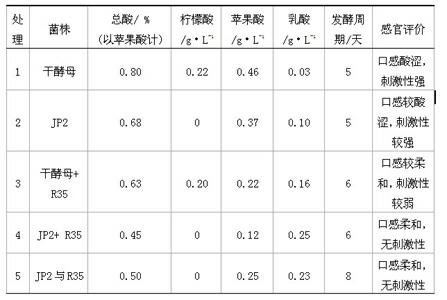Double-effect fermentation and biological acid reduction brewing method for fruit wine
A technology for fermenting organisms and fruit wine, which is applied in the field of fruit wine brewing, can solve problems such as limited range, and achieve the effect of reducing acidity, modifying the flavor of wine body, and promoting technological progress
- Summary
- Abstract
- Description
- Claims
- Application Information
AI Technical Summary
Problems solved by technology
Method used
Image
Examples
example 1
[0035] Example 1: Single-strain fermentation of yeast without acid-reducing function, single-strain fermentation of yeast with acid-reducing function, double-effect fermentation of yeast and lactic acid bacteria with acid-reducing function, segmentation of yeast and lactic acid bacteria with acid-reducing function Comparative experiments on the acid-reducing effect of fermentation:
[0036] The loquat juice containing 0.80% acid was placed in glass fermentation bottles, respectively, and fermented in the following ways: ① "Anqi" dry yeast single-strain fermentation; ②Saccharomyces cerevisiae JP2 single-strain fermentation; ③"Anqi" dry yeast and Double-effect fermentation of Lactobacillus casei R35: inoculate "Angel" dry yeast, and inoculate Lactobacillus casei R35 after the specific gravity drops to 0.994. ④ Double-effect fermentation of Saccharomyces cerevisiae JP2 and Lactobacillus casei R35: first inoculate Saccharomyces cerevisiae JP2 for fermentation, and then inoculate...
example 2
[0041] Example 2: Double-effect fermentation biological acid reduction method of loquat wine
[0042] The method includes the following steps:
[0043] 1. Juicing: After the fresh loquats are cored, crushed and squeezed, add 120mg / L of sulfur dioxide, and use sucrose to adjust the soluble solid content to 20% of the total. At this time, the acid content of the juice reaches 0.9% (apple acid meter).
[0044] 2. Alcoholic fermentation: the adjusted loquat juice is about 9.99×10 7 The inoculation amount of cfu / mL will be the Saccharomyces cerevisiae JP2 ( Saccharomyces cerevisiae JP2) Put in loquat juice, and carry out temperature-controlled fermentation at 20-25°C. During alcoholic fermentation, Saccharomyces cerevisiae JP2 can metabolize and consume part of malic acid and all of citric acid, initially reducing the acidity of loquat wine.
[0045] 3. Double-effect fermentation: During the alcoholic fermentation process, the specific gravity of the wine mash is detected, a...
example 3
[0052] Example 3: Double-effect fermentation biological acid reduction method of mountain wine
[0053] The method includes the following steps:
[0054] 1. Pretreatment: After destemming and crushing fresh mountain grapes, add 120mg / L sulfur dioxide, adjust the soluble solid content to 20% of the total with sucrose, and the acid content of the juice will reach 1.0% (calculated as malic acid) .
[0055] 2. Alcoholic fermentation: adjusted mountain grape juice (with skin), press about 1.00×10 6 The inoculum of cfu / mL was inserted into Saccharomyces cerevisiae J4 ( Saccharomyces cerevisiae J4). Temperature-controlled fermentation is carried out at 20-25°C. During alcoholic fermentation, Saccharomyces cerevisiae J4 can metabolize and consume part of the malic acid and all of the citric acid, initially reducing the acidity of the mountain wine.
[0056] 3. Double-effect fermentation: During the alcohol fermentation process, the specific gravity of the wine mash is detected...
PUM
 Login to View More
Login to View More Abstract
Description
Claims
Application Information
 Login to View More
Login to View More - R&D
- Intellectual Property
- Life Sciences
- Materials
- Tech Scout
- Unparalleled Data Quality
- Higher Quality Content
- 60% Fewer Hallucinations
Browse by: Latest US Patents, China's latest patents, Technical Efficacy Thesaurus, Application Domain, Technology Topic, Popular Technical Reports.
© 2025 PatSnap. All rights reserved.Legal|Privacy policy|Modern Slavery Act Transparency Statement|Sitemap|About US| Contact US: help@patsnap.com

